08.12.2017 Lecture 2. The road toward sustainability 1

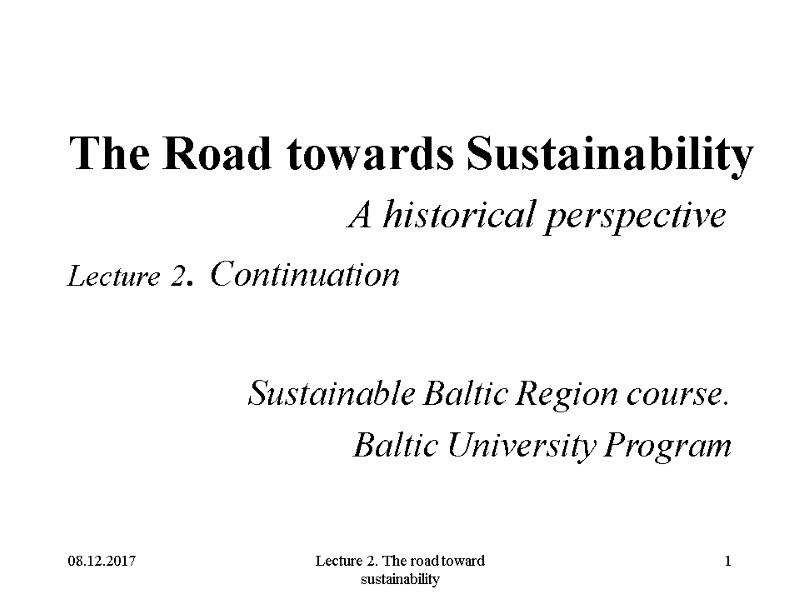
08.12.2017 Lecture 2. The road toward sustainability 1 The Road towards Sustainability A historical perspective Lecture 2. Continuation Sustainable Baltic Region course. Baltic University Program
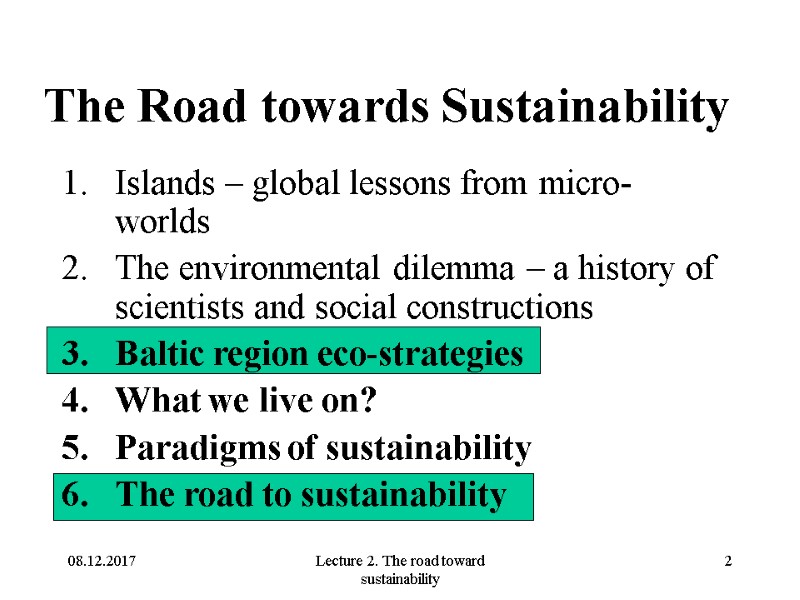
08.12.2017 Lecture 2. The road toward sustainability 2 The Road towards Sustainability Islands – global lessons from micro-worlds The environmental dilemma – a history of scientists and social constructions Baltic region eco-strategies What we live on? Paradigms of sustainability The road to sustainability
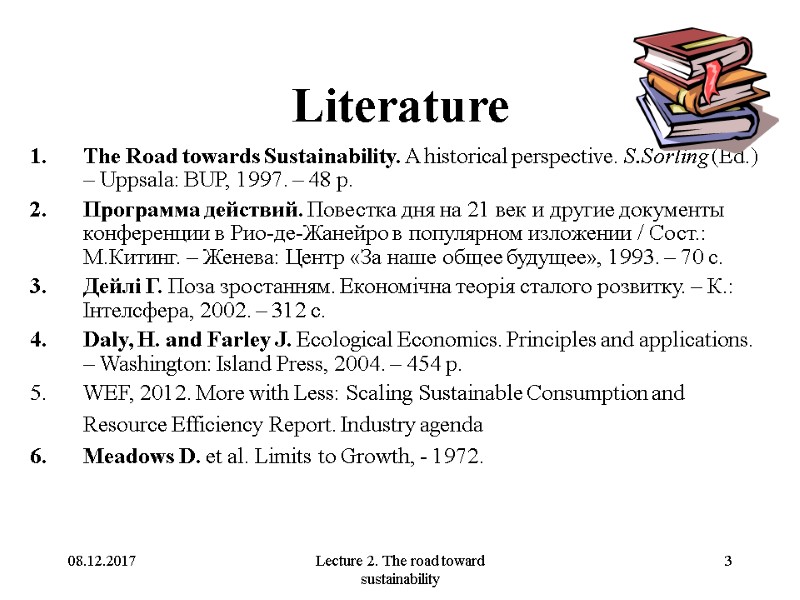
08.12.2017 Lecture 2. The road toward sustainability 3 Literature The Road towards Sustainability. A historical perspective. S.Sorling (Ed.) – Uppsala: BUP, 1997. – 48 p. Программа действий. Повестка дня на 21 век и другие документы конференции в Рио-де-Жанейро в популярном изложении / Сост.: М.Китинг. – Женева: Центр «За наше общее будущее», 1993. – 70 с. Дейлі Г. Поза зростанням. Економічна теорія сталого розвитку. – К.: Інтелсфера, 2002. – 312 с. Daly, H. and Farley J. Ecological Economics. Principles and applications. – Washington: Island Press, 2004. – 454 p. WEF, 2012. More with Less: Scaling Sustainable Consumption and Resource Efficiency Report. Industry agenda Meadows D. et al. Limits to Growth, - 1972.
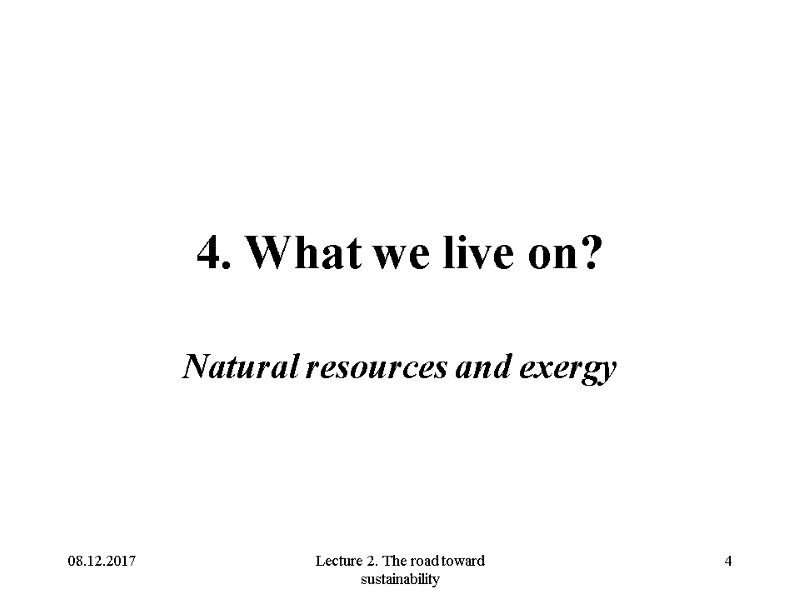
08.12.2017 Lecture 2. The road toward sustainability 4 4. What we live on? Natural resources and exergy
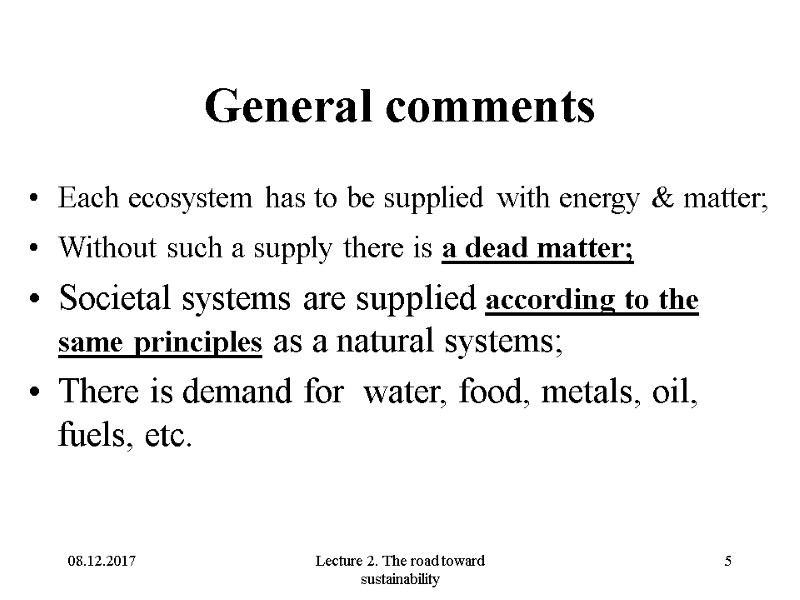
08.12.2017 Lecture 2. The road toward sustainability 5 General comments Each ecosystem has to be supplied with energy & matter; Without such a supply there is a dead matter; Societal systems are supplied according to the same principles as a natural systems; There is demand for water, food, metals, oil, fuels, etc.
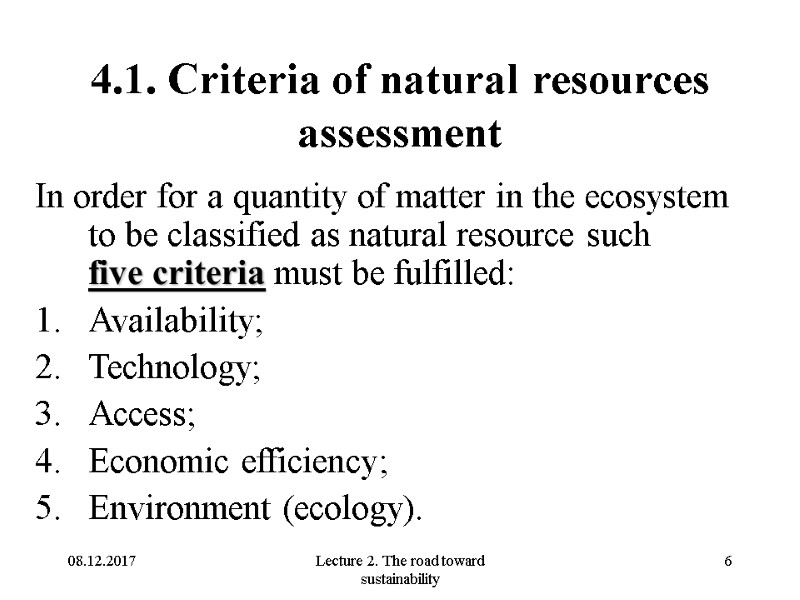
08.12.2017 Lecture 2. The road toward sustainability 6 4.1. Criteria of natural resources assessment In order for a quantity of matter in the ecosystem to be classified as natural resource such five criteria must be fulfilled: Availability; Technology; Access; Economic efficiency; Environment (ecology).
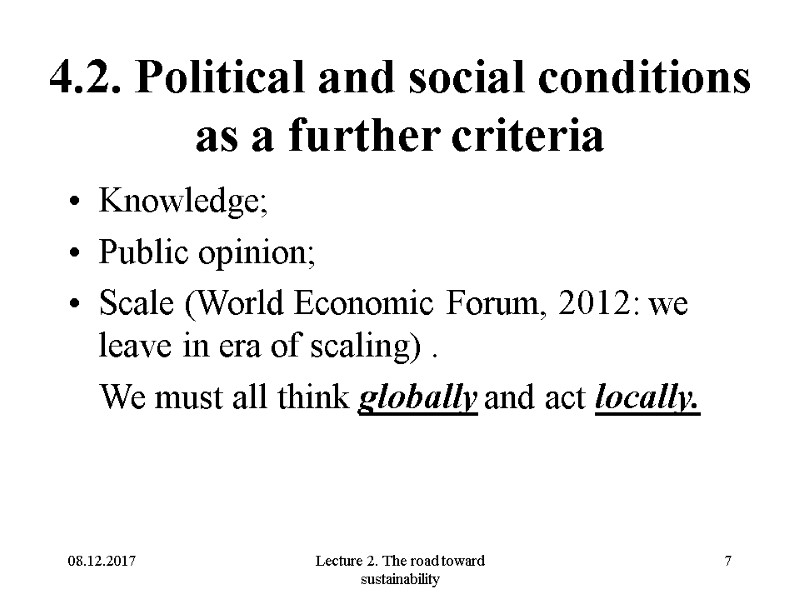
08.12.2017 Lecture 2. The road toward sustainability 7 4.2. Political and social conditions as a further criteria Knowledge; Public opinion; Scale (World Economic Forum, 2012: we leave in era of scaling) . We must all think globally and act locally.
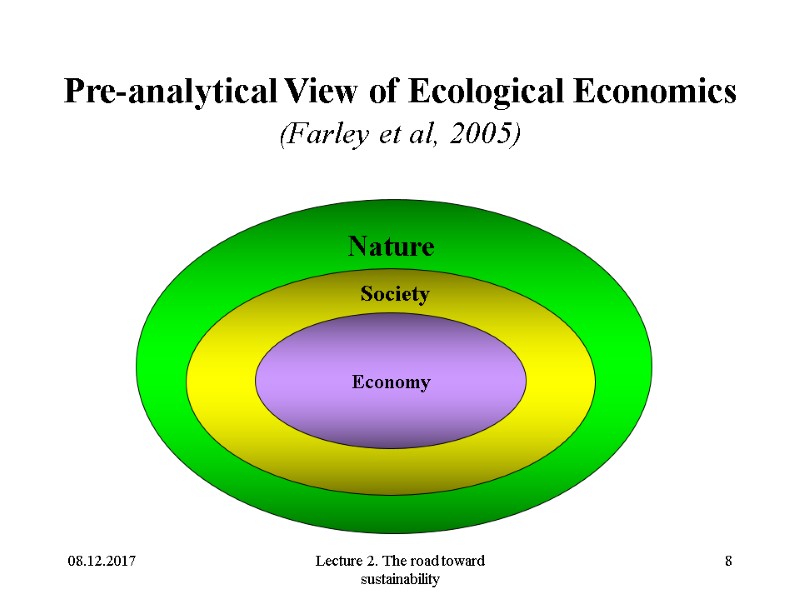
08.12.2017 Lecture 2. The road toward sustainability 8 Pre-analytical View of Ecological Economics (Farley et al, 2005)
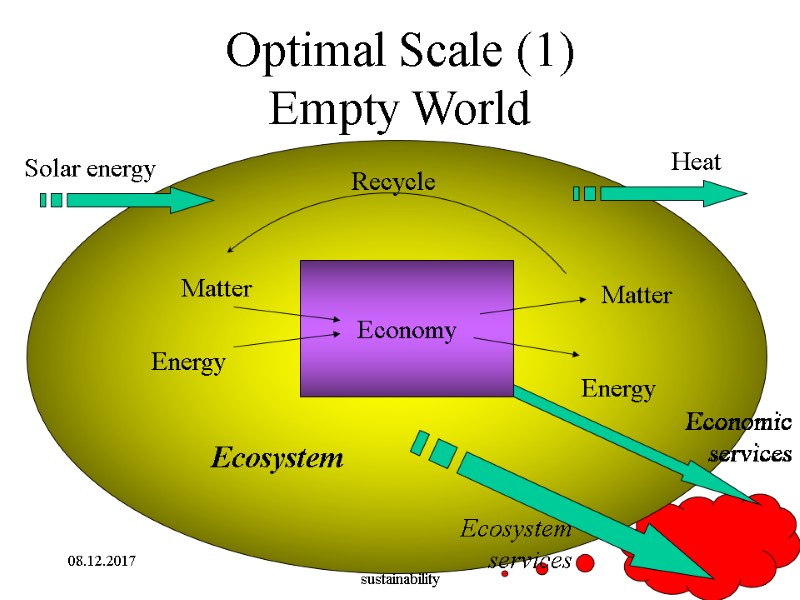
08.12.2017 Lecture 2. The road toward sustainability 9 Optimal Scale (1) Empty World Economy Matter Energy Matter Energy Recycle Ecosystem Solar energy Heat Economic services
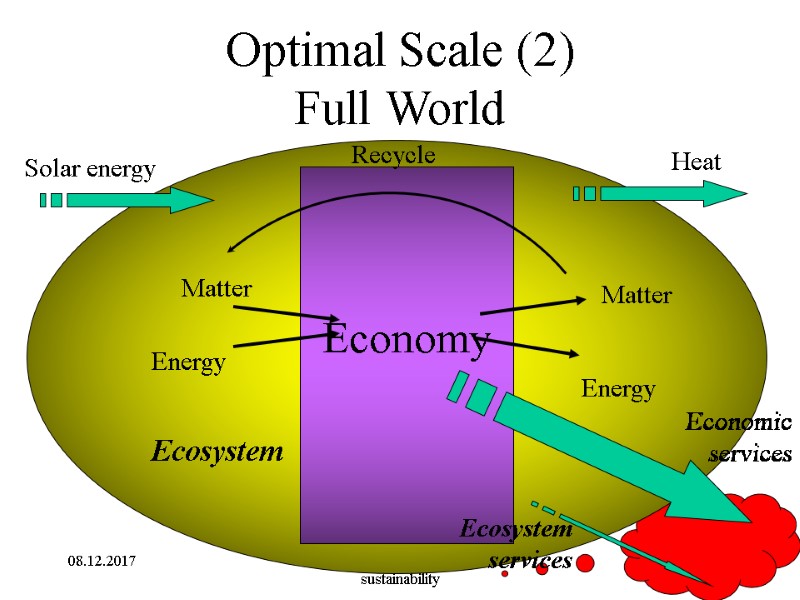
08.12.2017 Lecture 2. The road toward sustainability 10 Optimal Scale (2) Full World Economy Matter Energy Matter Energy Recycle Solar energy Heat Economic services
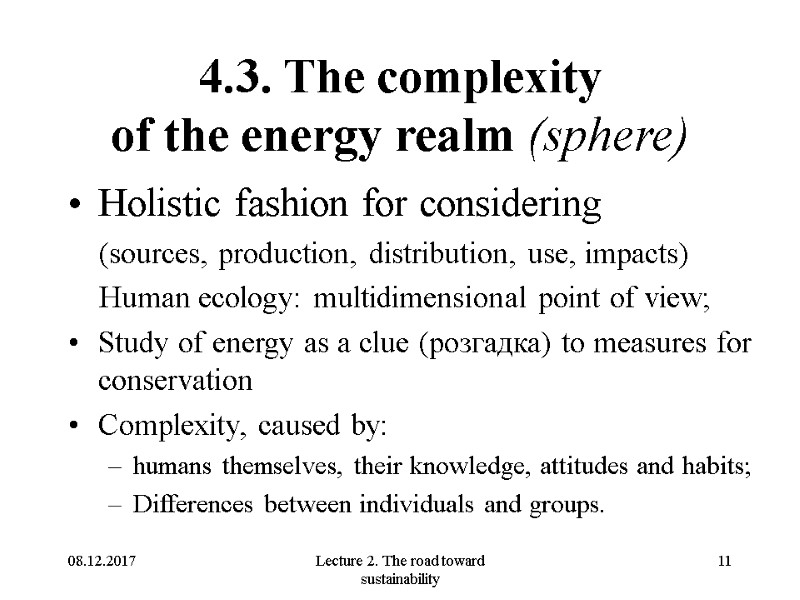
08.12.2017 Lecture 2. The road toward sustainability 11 4.3. The complexity of the energy realm (sphere) Holistic fashion for considering (sources, production, distribution, use, impacts) Human ecology: multidimensional point of view; Study of energy as a clue (розгадка) to measures for conservation Complexity, caused by: humans themselves, their knowledge, attitudes and habits; Differences between individuals and groups.
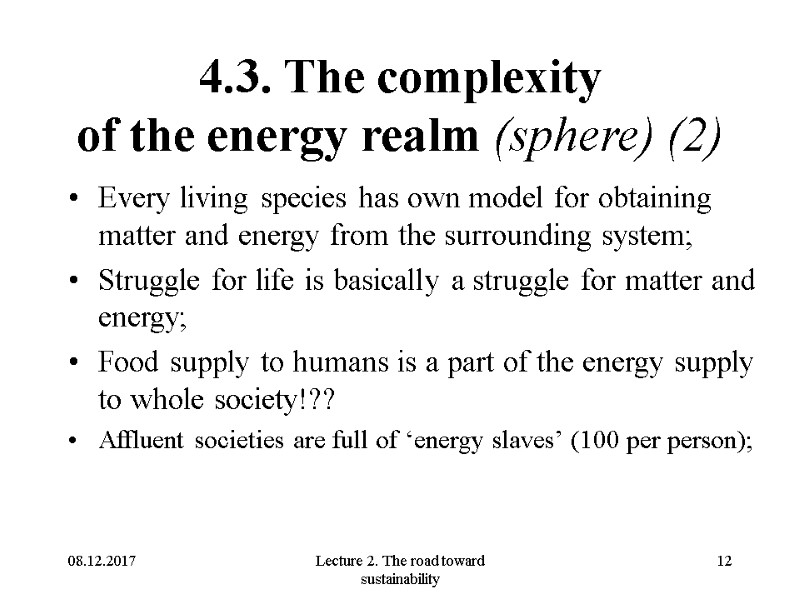
08.12.2017 Lecture 2. The road toward sustainability 12 4.3. The complexity of the energy realm (sphere) (2) Every living species has own model for obtaining matter and energy from the surrounding system; Struggle for life is basically a struggle for matter and energy; Food supply to humans is a part of the energy supply to whole society!?? Affluent societies are full of ‘energy slaves’ (100 per person);
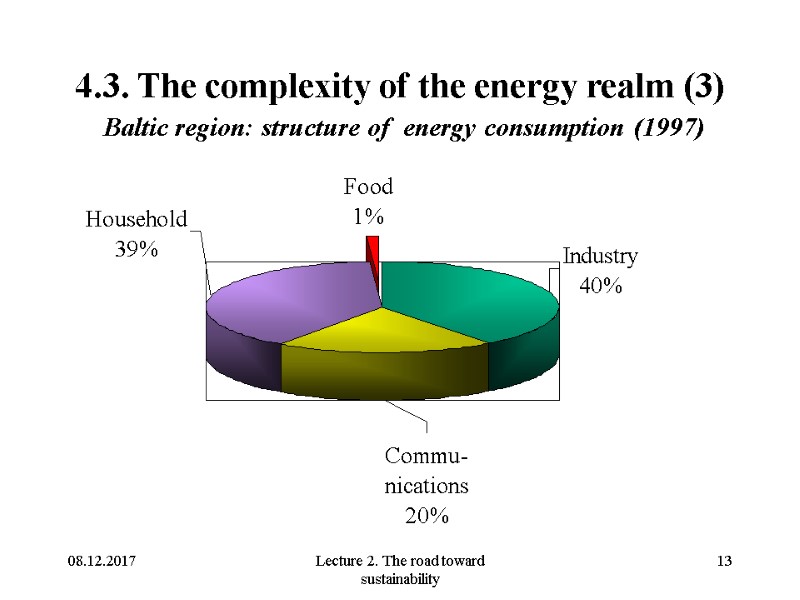
08.12.2017 Lecture 2. The road toward sustainability 13 4.3. The complexity of the energy realm (3) Baltic region: structure of energy consumption (1997)
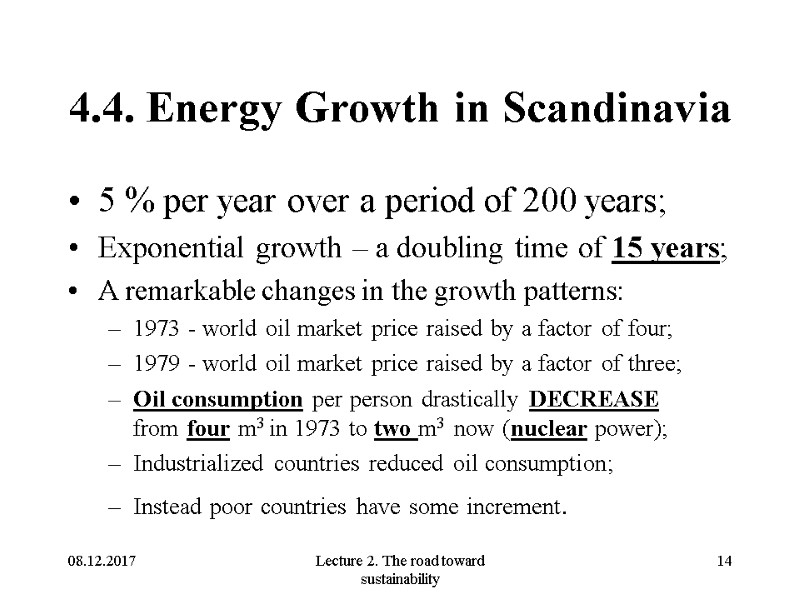
08.12.2017 Lecture 2. The road toward sustainability 14 4.4. Energy Growth in Scandinavia 5 % per year over a period of 200 years; Exponential growth – a doubling time of 15 years; A remarkable changes in the growth patterns: 1973 - world oil market price raised by a factor of four; 1979 - world oil market price raised by a factor of three; Oil consumption per person drastically DECREASE from four m3 in 1973 to two m3 now (nuclear power); Industrialized countries reduced oil consumption; Instead poor countries have some increment.
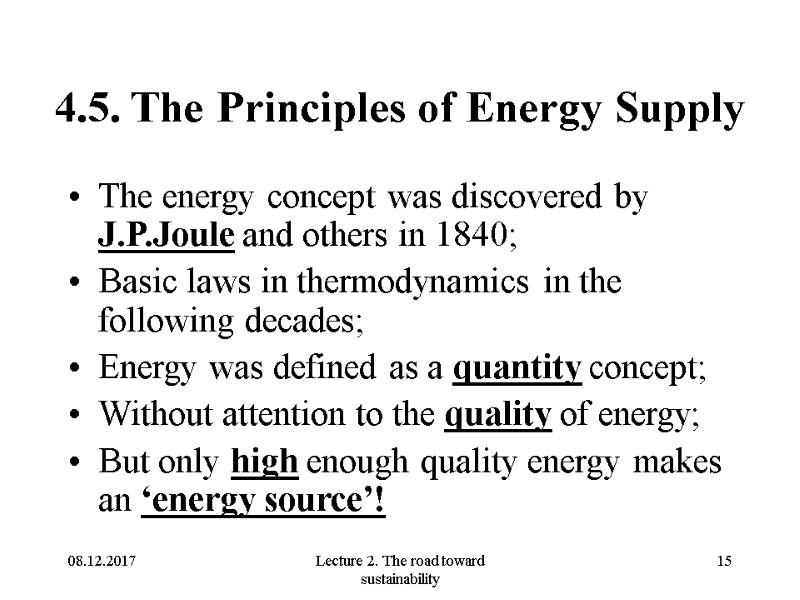
08.12.2017 Lecture 2. The road toward sustainability 15 4.5. The Principles of Energy Supply The energy concept was discovered by J.P.Joule and others in 1840; Basic laws in thermodynamics in the following decades; Energy was defined as a quantity concept; Without attention to the quality of energy; But only high enough quality energy makes an ‘energy source’!
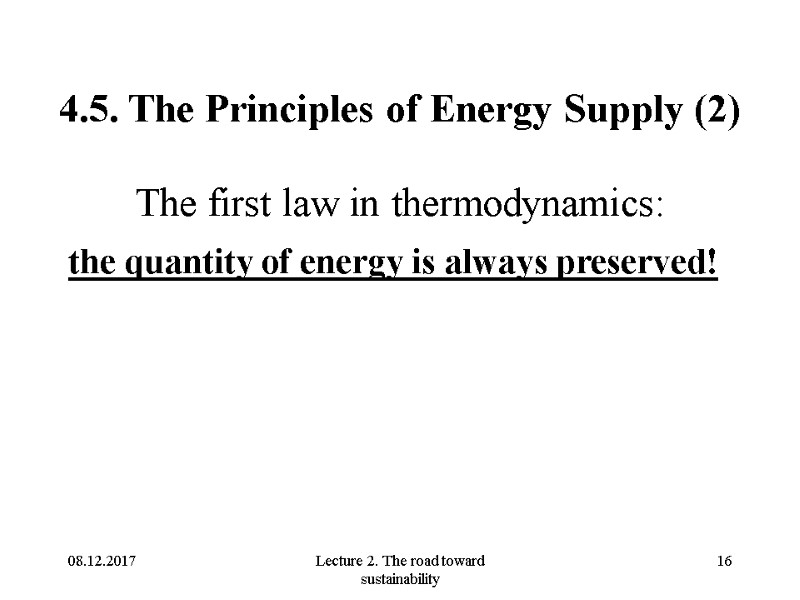
08.12.2017 Lecture 2. The road toward sustainability 16 4.5. The Principles of Energy Supply (2) The first law in thermodynamics: the quantity of energy is always preserved!
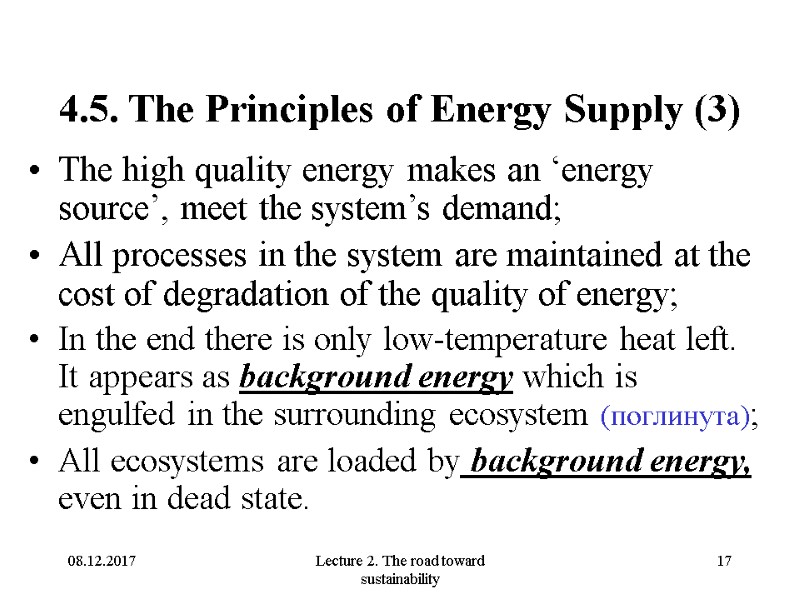
08.12.2017 Lecture 2. The road toward sustainability 17 4.5. The Principles of Energy Supply (3) The high quality energy makes an ‘energy source’, meet the system’s demand; All processes in the system are maintained at the cost of degradation of the quality of energy; In the end there is only low-temperature heat left. It appears as background energy which is engulfed in the surrounding ecosystem (поглинута); All ecosystems are loaded by background energy, even in dead state.
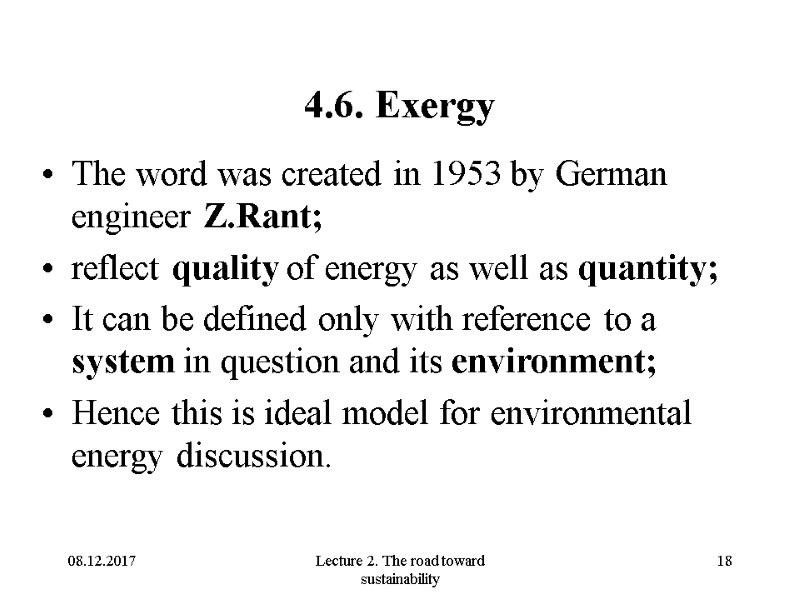
08.12.2017 Lecture 2. The road toward sustainability 18 4.6. Exergy The word was created in 1953 by German engineer Z.Rant; reflect quality of energy as well as quantity; It can be defined only with reference to a system in question and its environment; Hence this is ideal model for environmental energy discussion.
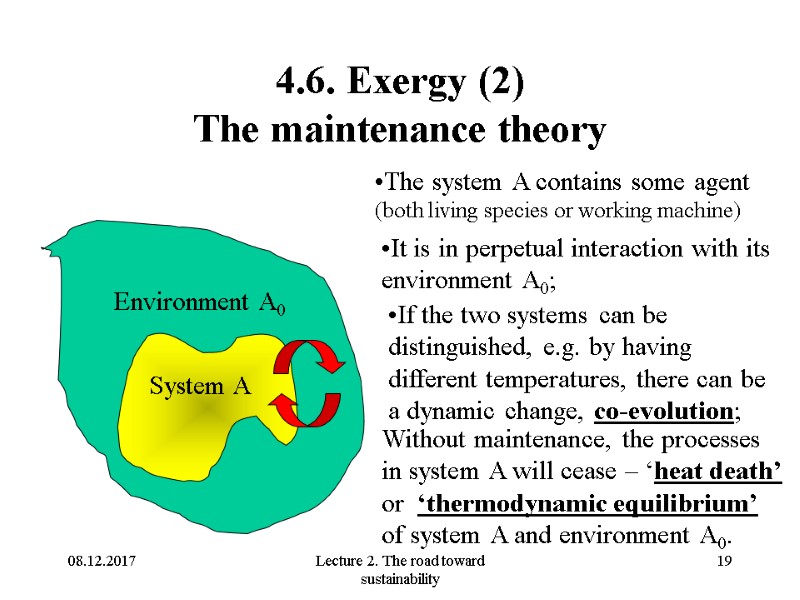
08.12.2017 Lecture 2. The road toward sustainability 19 4.6. Exergy (2) The maintenance theory The system A contains some agent (both living species or working machine) It is in perpetual interaction with its environment A0; Without maintenance, the processes in system A will cease – ‘heat death’ or ‘thermodynamic equilibrium’ of system A and environment A0.
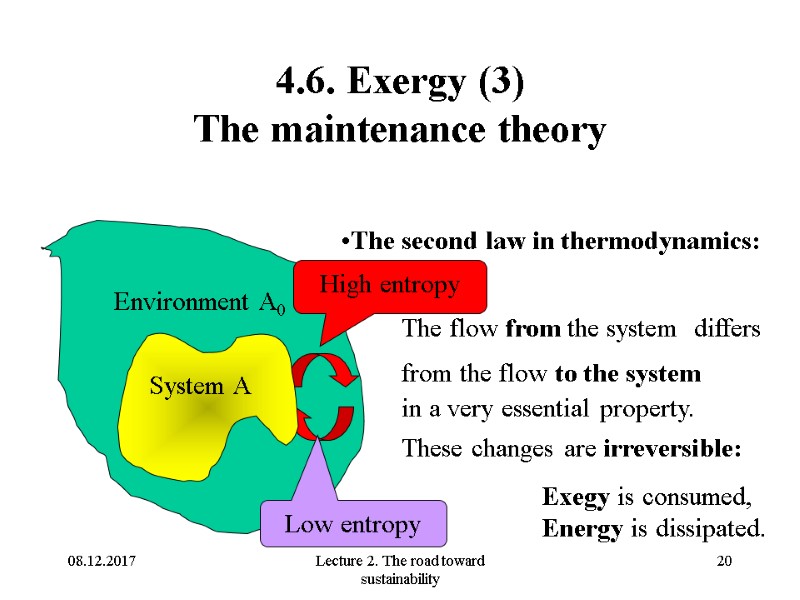
08.12.2017 Lecture 2. The road toward sustainability 20 4.6. Exergy (3) The maintenance theory The second law in thermodynamics: These changes are irreversible: Exegy is consumed, .....................Energy is dissipated. High entropy Low entropy
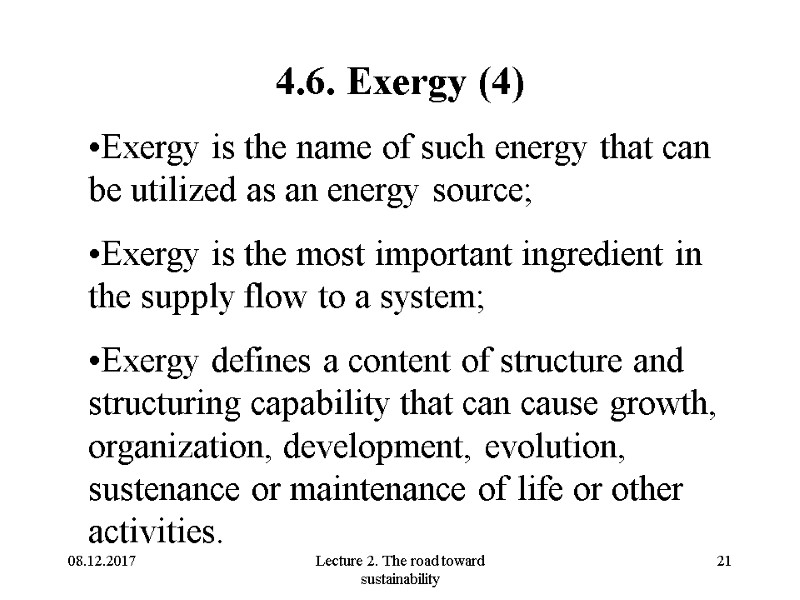
08.12.2017 Lecture 2. The road toward sustainability 21 4.6. Exergy (4) Exergy is the name of such energy that can be utilized as an energy source; Exergy is the most important ingredient in the supply flow to a system; Exergy defines a content of structure and structuring capability that can cause growth, organization, development, evolution, sustenance or maintenance of life or other activities.
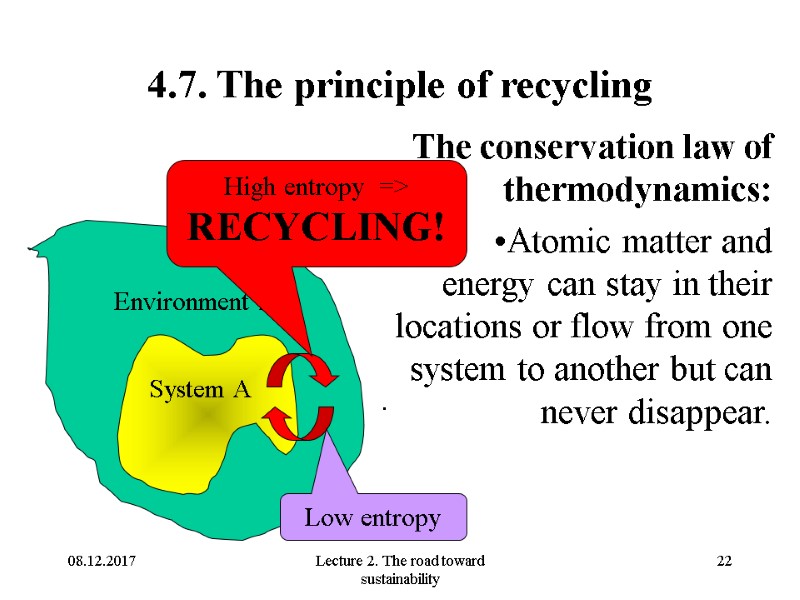
08.12.2017 Lecture 2. The road toward sustainability 22 4.7. The principle of recycling The conservation law of thermodynamics: Atomic matter and energy can stay in their locations or flow from one system to another but can never disappear. .
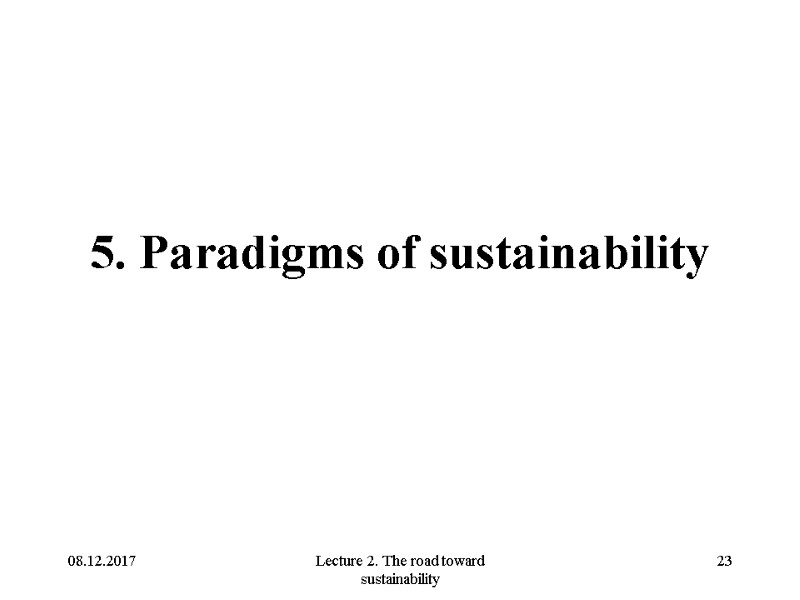
08.12.2017 Lecture 2. The road toward sustainability 23 5. Paradigms of sustainability
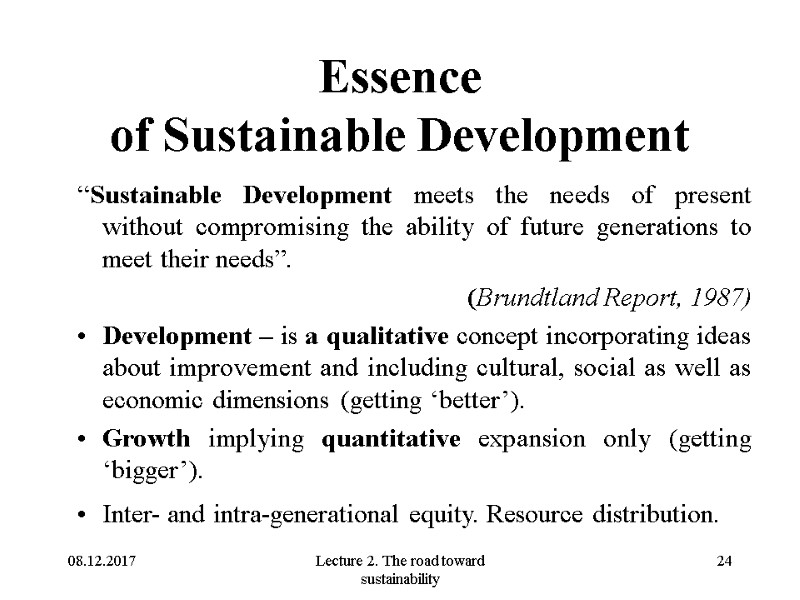
08.12.2017 Lecture 2. The road toward sustainability 24 Essence of Sustainable Development “Sustainable Development meets the needs of present without compromising the ability of future generations to meet their needs”. (Brundtland Report, 1987) Development – is a qualitative concept incorporating ideas about improvement and including cultural, social as well as economic dimensions (getting ‘better’). Growth implying quantitative expansion only (getting ‘bigger’). Inter- and intra-generational equity. Resource distribution.
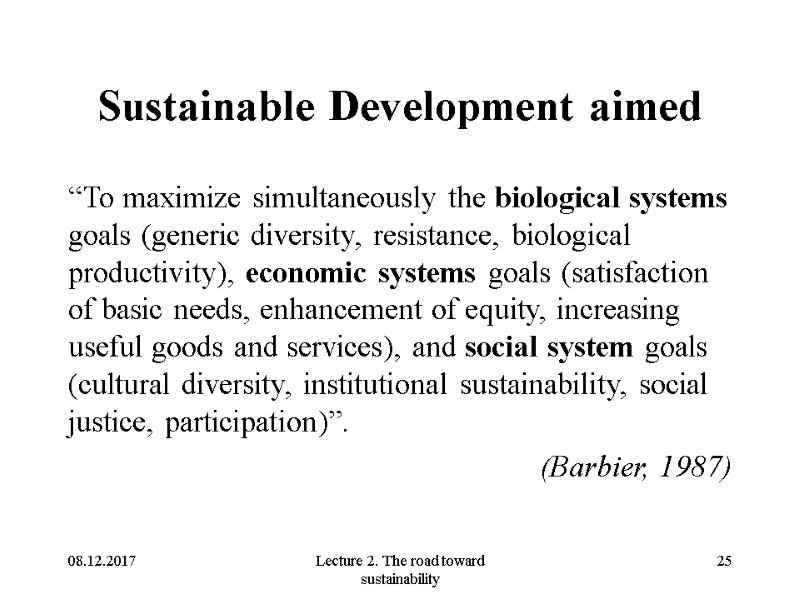
08.12.2017 Lecture 2. The road toward sustainability 25 Sustainable Development aimed “To maximize simultaneously the biological systems goals (generic diversity, resistance, biological productivity), economic systems goals (satisfaction of basic needs, enhancement of equity, increasing useful goods and services), and social system goals (cultural diversity, institutional sustainability, social justice, participation)”. (Barbier, 1987)
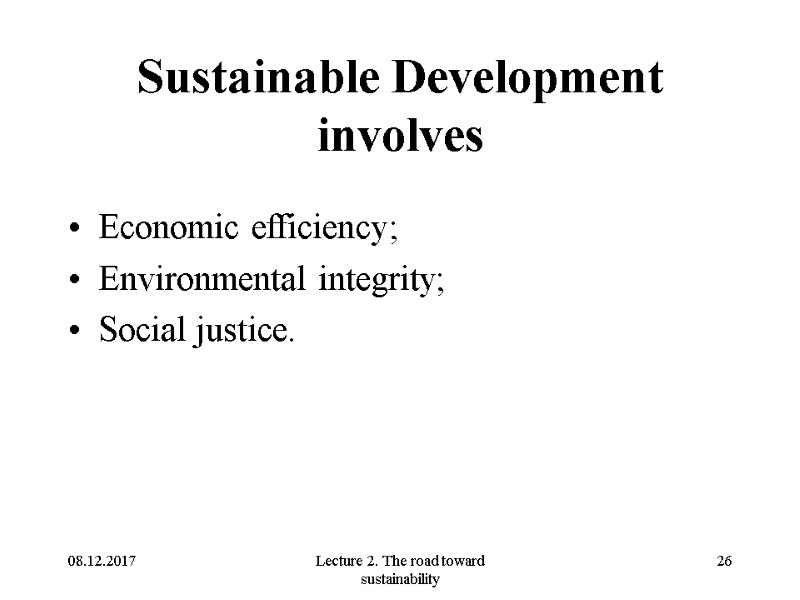
08.12.2017 Lecture 2. The road toward sustainability 26 Sustainable Development involves Economic efficiency; Environmental integrity; Social justice.
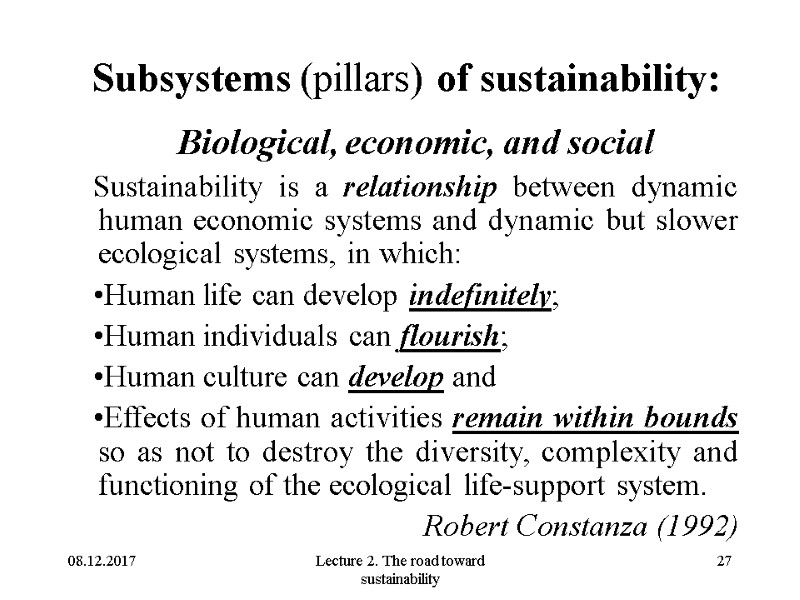
08.12.2017 Lecture 2. The road toward sustainability 27 Subsystems (pillars) of sustainability: Biological, economic, and social Sustainability is a relationship between dynamic human economic systems and dynamic but slower ecological systems, in which: Human life can develop indefinitely; Human individuals can flourish; Human culture can develop and Effects of human activities remain within bounds so as not to destroy the diversity, complexity and functioning of the ecological life-support system. Robert Constanza (1992)
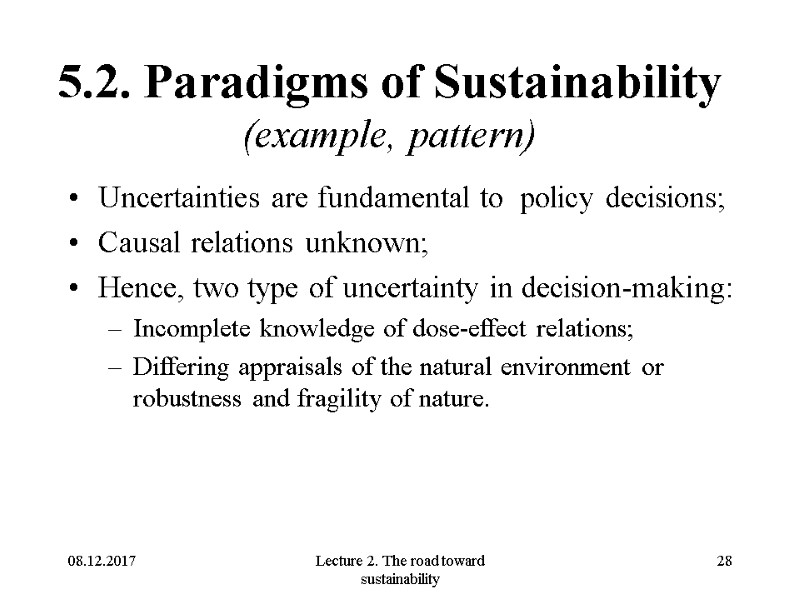
08.12.2017 Lecture 2. The road toward sustainability 28 5.2. Paradigms of Sustainability (example, pattern) Uncertainties are fundamental to policy decisions; Causal relations unknown; Hence, two type of uncertainty in decision-making: Incomplete knowledge of dose-effect relations; Differing appraisals of the natural environment or robustness and fragility of nature.
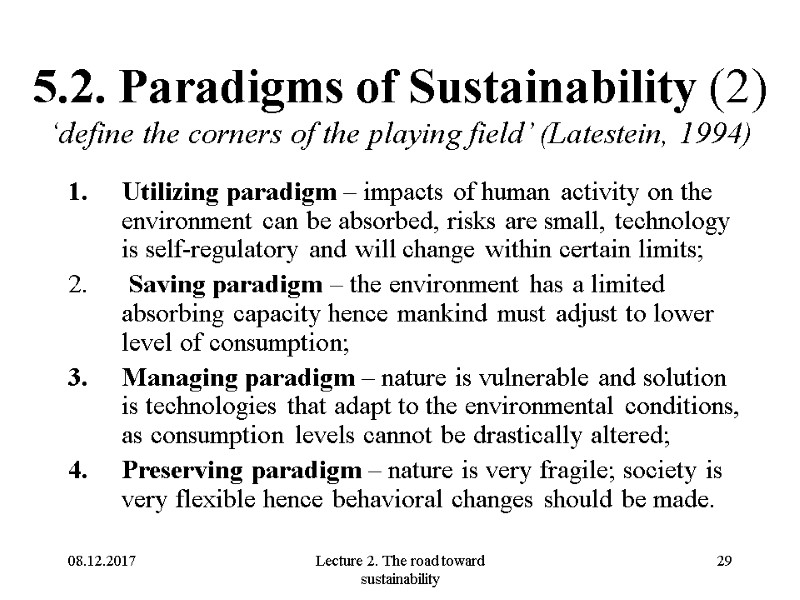
08.12.2017 Lecture 2. The road toward sustainability 29 5.2. Paradigms of Sustainability (2) ‘define the corners of the playing field’ (Latestein, 1994) Utilizing paradigm – impacts of human activity on the environment can be absorbed, risks are small, technology is self-regulatory and will change within certain limits; Saving paradigm – the environment has a limited absorbing capacity hence mankind must adjust to lower level of consumption; Managing paradigm – nature is vulnerable and solution is technologies that adapt to the environmental conditions, as consumption levels cannot be drastically altered; Preserving paradigm – nature is very fragile; society is very flexible hence behavioral changes should be made.
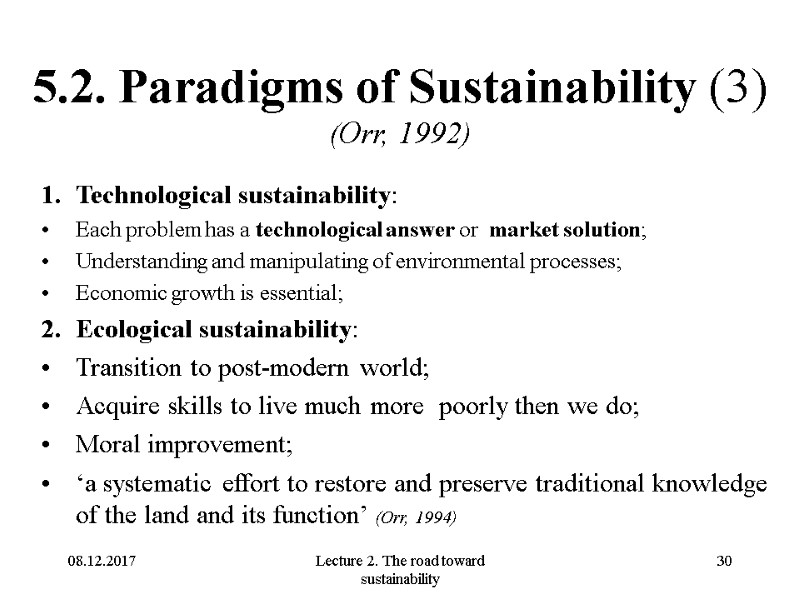
08.12.2017 Lecture 2. The road toward sustainability 30 5.2. Paradigms of Sustainability (3) (Orr, 1992) Technological sustainability: Each problem has a technological answer or market solution; Understanding and manipulating of environmental processes; Economic growth is essential; Ecological sustainability: Transition to post-modern world; Acquire skills to live much more poorly then we do; Moral improvement; ‘a systematic effort to restore and preserve traditional knowledge of the land and its function’ (Orr, 1994)
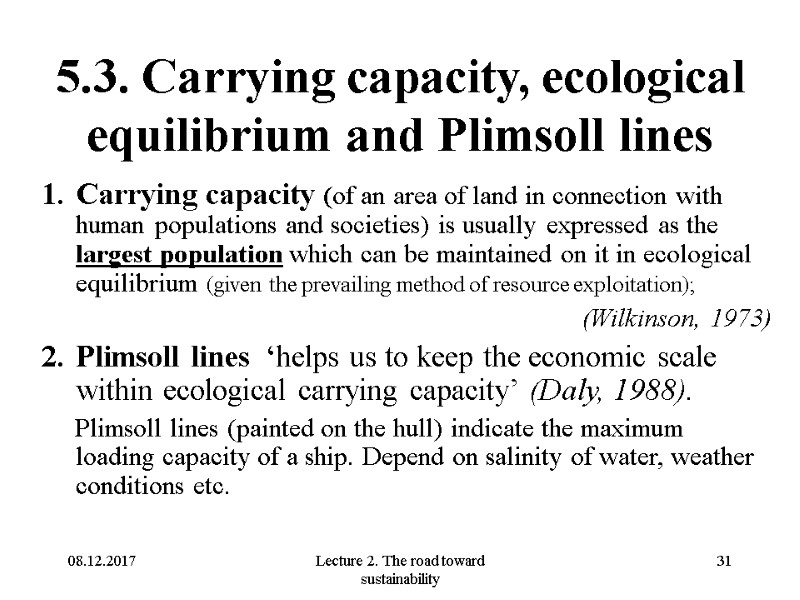
08.12.2017 Lecture 2. The road toward sustainability 31 5.3. Carrying capacity, ecological equilibrium and Plimsoll lines Carrying capacity (of an area of land in connection with human populations and societies) is usually expressed as the largest population which can be maintained on it in ecological equilibrium (given the prevailing method of resource exploitation); (Wilkinson, 1973) Plimsoll lines ‘helps us to keep the economic scale within ecological carrying capacity’ (Daly, 1988). Plimsoll lines (painted on the hull) indicate the maximum loading capacity of a ship. Depend on salinity of water, weather conditions etc.
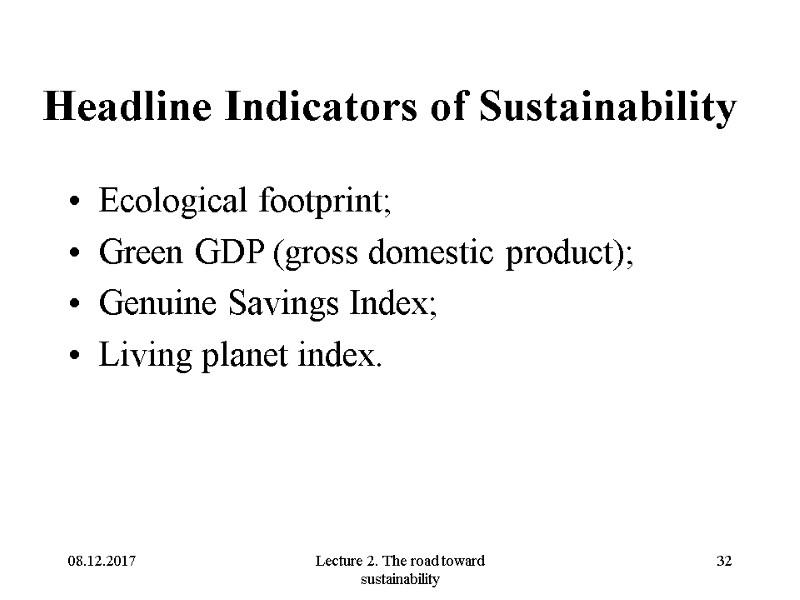
08.12.2017 Lecture 2. The road toward sustainability 32 Headline Indicators of Sustainability Ecological footprint; Green GDP (gross domestic product); Genuine Savings Index; Living planet index.
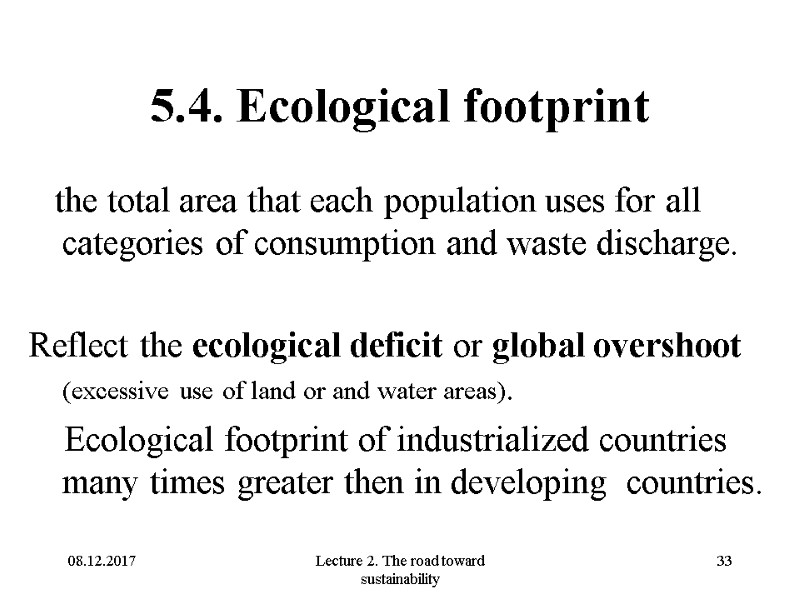
08.12.2017 Lecture 2. The road toward sustainability 33 5.4. Ecological footprint the total area that each population uses for all categories of consumption and waste discharge. Reflect the ecological deficit or global overshoot (excessive use of land or and water areas). Ecological footprint of industrialized countries many times greater then in developing countries.
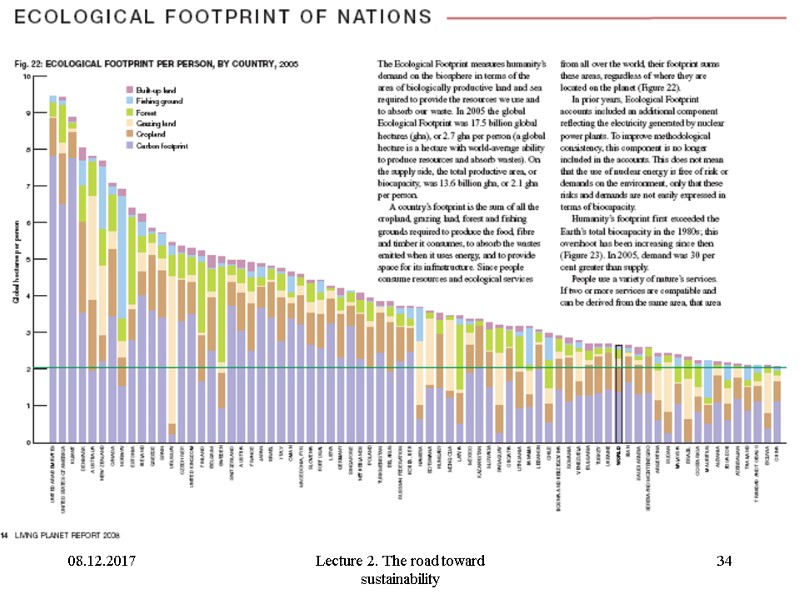
08.12.2017 Lecture 2. The road toward sustainability 34
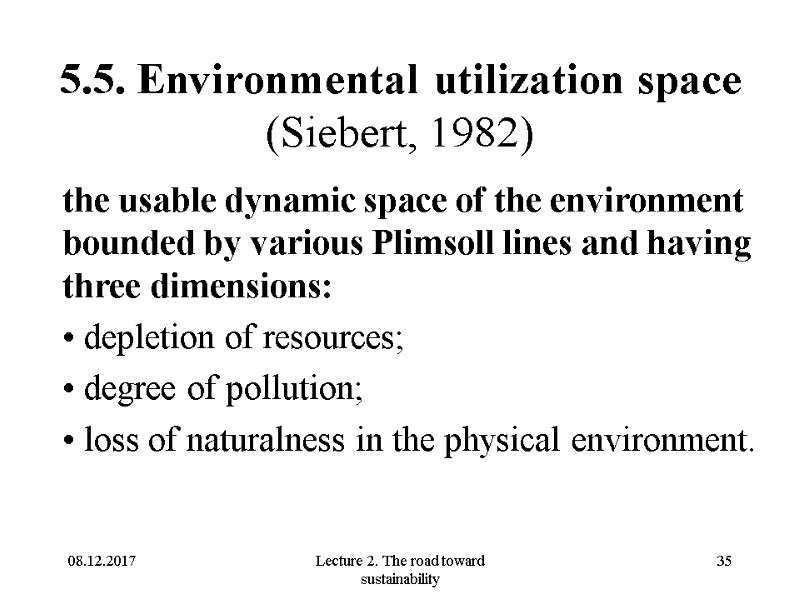
08.12.2017 Lecture 2. The road toward sustainability 35 5.5. Environmental utilization space (Siebert, 1982) the usable dynamic space of the environment bounded by various Plimsoll lines and having three dimensions: depletion of resources; degree of pollution; loss of naturalness in the physical environment.
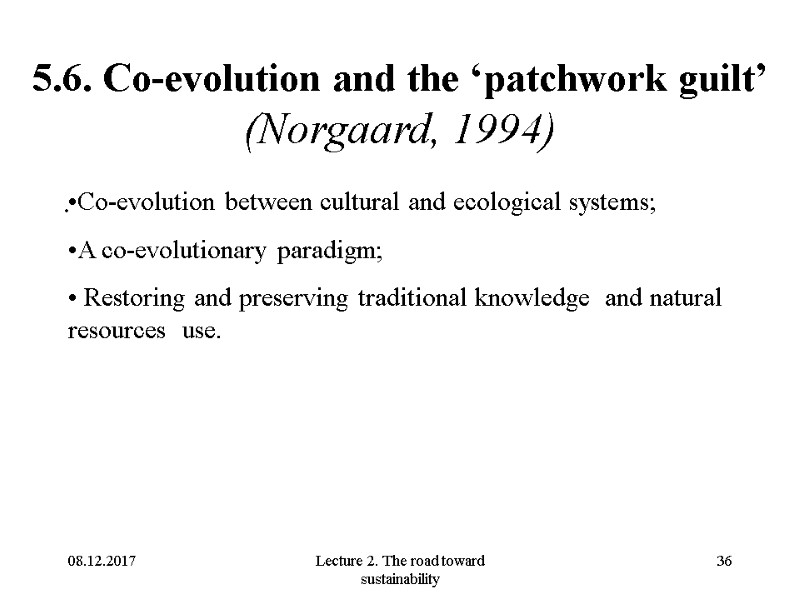
08.12.2017 Lecture 2. The road toward sustainability 36 5.6. Co-evolution and the ‘patchwork guilt’ (Norgaard, 1994) . Co-evolution between cultural and ecological systems; A co-evolutionary paradigm; Restoring and preserving traditional knowledge and natural resources use.
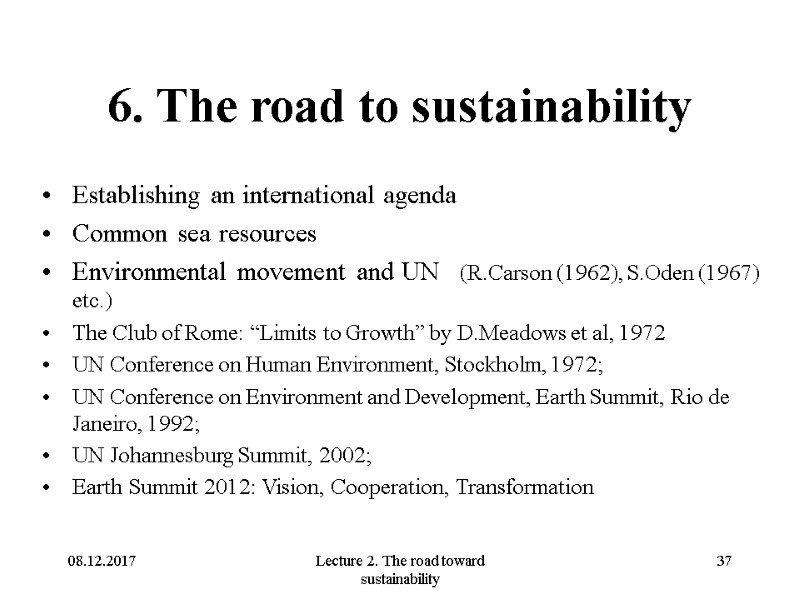
08.12.2017 Lecture 2. The road toward sustainability 37 6. The road to sustainability Establishing an international agenda Common sea resources Environmental movement and UN (R.Carson (1962), S.Oden (1967) etc.) The Club of Rome: “Limits to Growth” by D.Meadows et al, 1972 UN Conference on Human Environment, Stockholm, 1972; UN Conference on Environment and Development, Earth Summit, Rio de Janeiro, 1992; UN Johannesburg Summit, 2002; Earth Summit 2012: Vision, Cooperation, Transformation
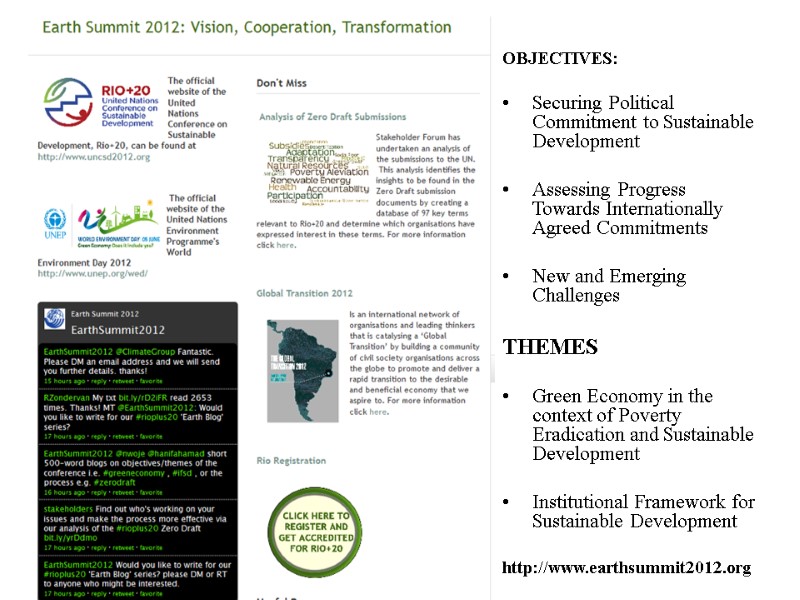
08.12.2017 Lecture 2. The road toward sustainability 38 OBJECTIVES: Securing Political Commitment to Sustainable Development Assessing Progress Towards Internationally Agreed Commitments New and Emerging Challenges THEMES Green Economy in the context of Poverty Eradication and Sustainable Development Institutional Framework for Sustainable Development http://www.earthsummit2012.org
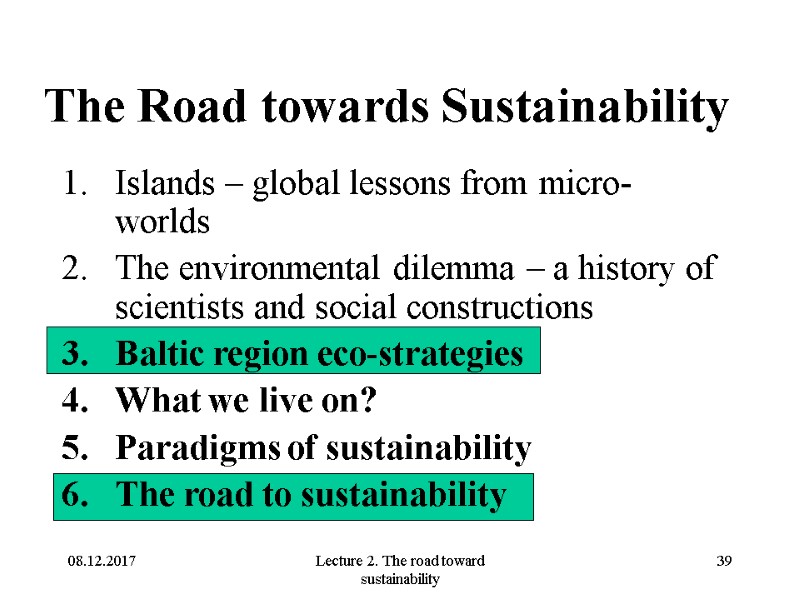
08.12.2017 Lecture 2. The road toward sustainability 39 The Road towards Sustainability Islands – global lessons from micro-worlds The environmental dilemma – a history of scientists and social constructions Baltic region eco-strategies What we live on? Paradigms of sustainability The road to sustainability
9054-lecture_1_2._road_twd_sust-ty[1].ppt
- Количество слайдов: 39

